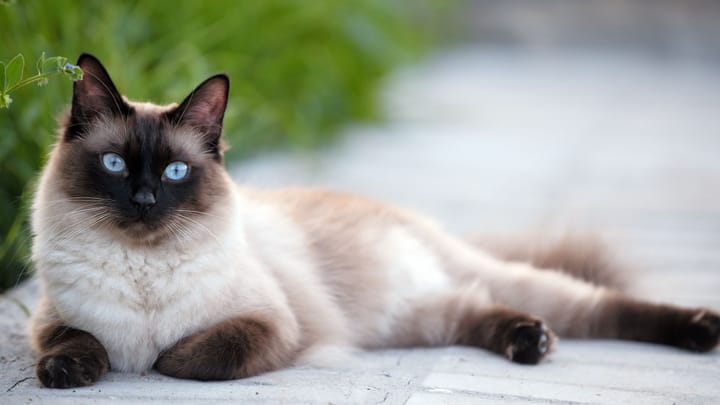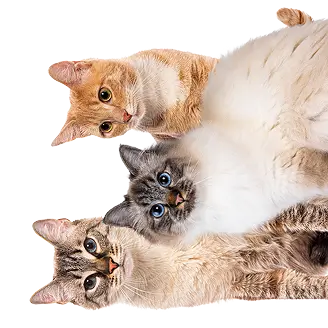Siamese Cat
Other names : Meezer, Meeze


When it comes to elegance, few cats can rival the Siamese. Often dubbed ‘the prince of cats’, this breed is instantly recognisable by its sleek build, striking triangular face and large, pointed ears. Their intense blue eyes are captivating; it’s easy to get lost in their gaze. But while their graceful appearance wins admiration, their voice tends to divide opinion. The Siamese is famously vocal, with a distinctive, raspy meow that’s unlike any other. Some find it endearing, others less so, but one thing’s certain: it won’t go unnoticed.
|
Life expectancy |
The Siamese Cat has a life expectancy of between 15 and 20 years |
|
Temperament |
|
|
Adult size |
Female
Approximately 12 in
Male
Approximately 12 in
|
|
Adult weight |
Female
Between 4 and 7 lb
Male
Between 7 and 11 lb
|
|
Coat colour
Seal, blue, chocolate, lilac, cinnamon, fawn. Caramel and apricot are accepted by a small number of associations, but rejected by others. |
Black Brown Blue |
|
Type of coat
Short. |
Short |
|
Eye colour
Blue, aquamarine. |
Blue
|
|
Purchase price |
The Siamese Cat costs between £400 and £800 |
All Siamese kittens are born completely white. Their unique colouring develops over time due to a temperature-sensitive gene. In simple terms, this gene only produces colour in cooler areas of the body. Because the kitten’s body is warm in the womb, no colour appears at birth. As they grow, the cooler parts of their body, such as the ears, face, paws and tail, gradually darken, creating the classic pointed pattern the breed is known for.
More details about the Siamese Cat
Siamese Cat: Origins and history
The Siamese cat originates from Siam (modern-day Thailand), where it was considered sacred and kept by royalty and Buddhist monks. Ancient manuscripts from the 14th century describe pale cats with dark markings, often found living in temples and palaces. One legend suggests that their occasional squint originated from guarding sacred vases, where they would stare at them so intently that they developed crossed eyes. The breed first arrived in Britain in the mid-1800s, when Owen Gould, a British consul general, brought home two kittens from a royal cattery. French diplomat Auguste Pavie followed shortly after with another pair. Although early breeding efforts struggled, by the 1920s, the Siamese had begun to gain popularity. In the 1930s, stricter breeding standards were introduced to safeguard the breed’s health and ensure its long-term viability.
Physical characteristics of the Siamese Cat
The Siamese is a sleek, slender and muscular cat with an elegant build. Its fine-boned frame is balanced by a long neck, slim legs and a tapering tail, giving it a graceful, athletic appearance.
Siamese Cat: Characteristics
Siamese Cat: Behaviour
Training a Siamese Cat
Siamese cats are highly intelligent and can be trained with patience and consistency. They respond well to positive reinforcement, especially treats, toys or praise. Start with simple commands like “sit” or “come,” and keep sessions short and fun. Puzzle feeders and clicker training work well with this mentally active breed. Siamese cats also enjoy learning tricks or walking on a lead, which helps burn off energy and strengthens the bond with their human. Avoid harsh discipline, it’s ineffective and can damage trust. With the right approach, training a Siamese can be both rewarding and enjoyable.
Breed compatibility Siamese Cat
Siamese Cat: Purchase price
The average purchase price of a Siamese cat ranges from £400 to £800, depending on factors such as lineage, breeder reputation, age and sometimes sex. For ongoing care, it's sensible to budget around £25 per month to provide a high-quality diet and help maintain their overall health.
Siamese Cat: Shedding
Light
Siamese cats are moderate shedders, so loose hair around the home is generally minimal compared to long-haired breeds.
Siamese Cat: Grooming
Siamese cats typically require only a weekly brushing to keep their short coat in good condition. However, during moulting periods, more frequent grooming may be needed to manage shedding.
Siamese Cat: Health
Siamese cats typically have a life expectancy of 15 to 20 years, with some living even longer when well cared for.
Siamese cats have a short coat with little to no undercoat, which means they aren’t well-suited to cold or extreme temperatures. They’re much more comfortable in a warm, indoor environment.
Siamese cats burn a lot of energy due to their active nature, but it’s still important to manage portion sizes carefully. A vet can help assess their nutritional needs to ensure they stay in good shape without the risk of overeating.
Like all breeds, Siamese cats can be prone to certain hereditary and health conditions. While many live long, healthy lives, it’s important to be aware of potential risks:
- Progressive retinal atrophy (PRA): this inherited condition causes the gradual deterioration of the retina, leading to partial or complete blindness. PRA can appear early in life — sometimes in the first few months — or later in adulthood. In slower-developing cases, cats may adapt well to their reduced vision over time
- Renal amyloidosis: though rare, this hereditary condition is always serious and unfortunately fatal. It typically affects cats between one and five years of age and progresses rapidly. Symptoms resemble those of kidney failure. There is currently no screening test available, as the genetic causes have yet to be identified
- Oral health issues: Siamese cats can also suffer from common feline dental problems, including gingivitis and periodontal disease. Regular dental care and vet check-ups are recommended
- Vitiligo: some Siamese cats may be more prone to developing vitiligo, a skin condition that results in patches of depigmented hair or skin. While it is purely cosmetic and not harmful, it may cause noticeable changes in appearance
Siamese cats can be paired with certain other breeds for breeding purposes, including the Balinese (the long-haired variety of the Siamese), Oriental, Javanese, and Mandarin (also known as the Oriental Longhair). These breeds share similar characteristics and ancestry, making them compatible in recognised breeding programmes.
Do you want a Siamese Cat cat ?
Frequently asked questions
What is special about Siamese cats?
Siamese are definitely one of a kind. They are one of the only cat breeds to hail from Asia, and they have very unique colouring (darker spots on their face, ears, tail, and feet). They are also very unique in their character: They are quite extroverted and love to play and interact with their humans. Considered to be “dog-like”, they get very attached to their owners and can suffer from separation anxiety if left alone for too long. They are very chatty, and have very distinctive, high-pitched meows.
Are Siamese cats aggressive?
Siamese cats are at higher risk of becoming aggressive if they are not properly trained. Indeed, Siamese cats are very energetic, very sensitive, and very loving towards their humans. This combination results in some individuals pawing or even biting for attention. Another common character trait of this breed is jealousy. However, if you provide your Siamese with enough physical and mental exercise, socialisation, and training, your cat can grow up to be a very well-behaved pet.
Do Siamese cats like to cuddle?
Siamese cats are very affectionate with people and love to cuddle. In fact, they’re a very demanding, needy breed of cat, so you should be prepared to give them lots of attention.
Check out the 5 most affectionate cat breeds
At what age do Siamese cats calm down?
Usually, cats mature at around 8 to 12 months of age. But Siamese cats mature a lot more slowly. It’s only around 2 years of age that they start to calm down, so be prepared for a very energetic and possibly capricious kitty in their first few months at home.
Find out how to best train your kitten
Why are Siamese cats so crazy?
Siamese cats are sometimes described as having erratic behaviour. This is because they are an extroverted breed and are also very sensitive. They need attention, mental stimulation, and proper training. However, another reason why your Siamese might be acting “crazy” is that they suffer from Feline Hyperesthesia Syndrome. This is quite common in oriental breeds and can cause hyper-sensitivity to the skin. This means your cat could act out when being touched. Other symptoms include self-mutilation, excessive licking, crying or random bouts of running.
Learn more about feline hyperesthesia









